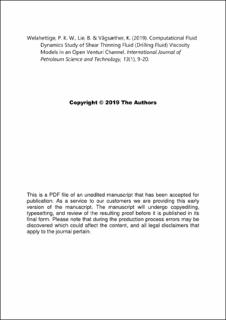| dc.contributor.author | Welahettige, Prasanna Kumara Welahetti | |
| dc.contributor.author | Lie, Bernt | |
| dc.contributor.author | Vågsæther, Knut | |
| dc.date.accessioned | 2020-03-25T11:11:32Z | |
| dc.date.available | 2020-03-25T11:11:32Z | |
| dc.date.created | 2019-11-27T11:26:43Z | |
| dc.date.issued | 2019 | |
| dc.identifier.citation | International Journal of Petroleum Science and Technology. 2019, 13 (1), 9-20 | en_US |
| dc.identifier.issn | 0973-6328 | |
| dc.identifier.uri | https://hdl.handle.net/11250/2648552 | |
| dc.description.abstract | We aim to develop an improved kick/loss detection technology by developing smart flow-sensor technology for returned flow from the oil well in open Venturi channels. This is a detailed study about a capacity of use of nonNewtonian fluid models in open Venturi channels. A water-based drilling fluid was used for the experiments. According to the rheometer results, at low shear rates, the fluid behaves as a pseudoplastic fluid, and at high shear rates, the fluid shows Newtonian properties. The experimental drilling fluid can be modelled with the power-law (PL) model, the Herschel-Bulkley (HB) model, the Carreau viscosity model, and the Cross viscosity model. Experimental flow depth measurements in an open Venturi channel were used to validate the simulation results. For the complete open channel, the strain rate range was 0.02 to 2100 1/s. The highest strain rate was on the walls of the channel, with 2100 1/s, while the fluid near to the free surface had a strain rate range of 0.02 to 200 1/s. All non-Newtonian models mentioned above can be used for the drilling fluid at a shear rate range of 0 to 2100 1/s in open Venturi channel flows. Even though different non-Newtonian models predict different wall shear stresses, these differences do not significantly affect the open channel flow depth and velocity values. | en_US |
| dc.language.iso | eng | en_US |
| dc.relation.uri | https://www.ripublication.com/ijpst19/ijpstv13n1_02.pdf | |
| dc.title | Computational Fluid Dynamics Study of Shear Thinning Fluid (Drilling Fluid) Viscosity Models in an Open Venturi Channel | en_US |
| dc.type | Journal article | en_US |
| dc.type | Peer reviewed | en_US |
| dc.description.version | acceptedVersion | en_US |
| dc.source.pagenumber | 9-20 | en_US |
| dc.source.volume | 13 | en_US |
| dc.source.journal | International Journal of Petroleum Science and Technology | en_US |
| dc.source.issue | 1 | en_US |
| dc.identifier.cristin | 1752990 | |
| cristin.ispublished | true | |
| cristin.fulltext | original | |
| cristin.qualitycode | 1 | |
